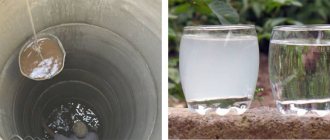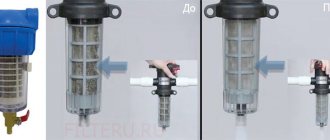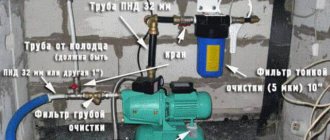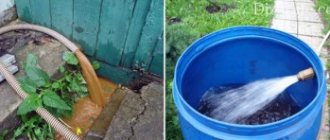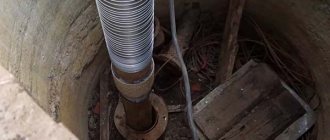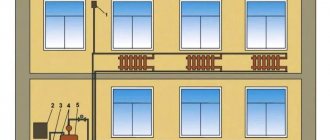When casing a well, it is important to select high-quality material for this. Until today, the most popular systems have been made of plastic, for example, HDPE. But increasingly, not only plastic, but also metal began to be used for wells. Which type is actually optimal and what is it best suited for? Let's look into this issue. Casing pipe is used for wells. Installed by drilling to supply water. It is used in summer cottages or in private residential buildings. It helps to restrain soil shedding inside the walls of the well. PVC and other types of plastic are the most popular.
↑ Drilling water wells
Having analyzed the content of the websites of most drilling companies, we were struck by the paucity, wretchedness, and sometimes outright illiteracy of the information presented. One of two things: either those who call themselves drilling companies know nothing about hydrogeology, or they consider their potential clients to be suckers and idiots.
In this article, we tried to briefly outline the main provisions that will help people who are planning to drill a well on their site, independently understand the difficult issues of hydrogeology, drilling technology, understand who is who and make a choice based not only on price analysis.
Tips and tricks
For those who are serious about creating a well on their own, the following tips and recommendations will be useful::
- To ensure that the water is always clean and fresh, it is recommended to equip the well in such a way as to ensure air circulation.
- Before using water from a well for daily needs, it is recommended that it be analyzed. As a rule, when the water quality is low, it is necessary to select a suitable filter.
- And finally, you should take water for analysis of composition and domestic needs no earlier than a few days after completion of work, otherwise the results may be unreliable.
Before using a well, it is important to equip it with a filter Source tagbur.ru
↑ Properly made wells
Properly made wells do not “float”, do not “silt up”, pumps do not get stuck in them, and groundwater, overlying formation and sewage water do not get into them. They are durable. Their service life is 40 years or more. You forget about the well - you just always have water in your house.
Unfortunately, that glorious generation of hydrogeologists and drillers who made WATER, not wells, has passed away. Do you feel the difference?
A generation has come whose main goal is to cut money and “spoil” clients with all sorts of “sands,” “limestones,” and other “artesian waters.”
It is a deep misconception to think that everyone makes wells the same way.
Therefore, this is important information for visitors to our website and potential customers, and for employees of drilling companies - a short educational program (which means eliminating illiteracy).
The main advantages of plastic
A material such as HDPE has a number of useful characteristics, including:
- long service life - more than 50 years;
- chemical resistance;
- absolute resistance to corrosion;
- light weight;
- good tightness;
- low cost;
- easy to install.
The easiest way to install such casing systems is if they are threaded. This is the best option for wells of any type.
↑ Search for water
We will disappoint you, but there are still no reliable methods for determining the depth of the aquifer below the second layer from the daylight surface.
In geophysics, when searching for mineral deposits, a good result is considered to be confirmation of predictions with a probability of 9-13%. When searching for water, this figure is even lower.
A search method called “dowsing” is extremely popular among people. This is when your tipsy neighbor walks around your site with two aluminum wires bent in the letter “g” and with a smart look shows where to drill a well. Since 1984 We keep statistics of such forecasts, including the predictions of the 11 most famous dowsers of the then Soviet Union, and today we have 86 documented cases of verification. The given forecast was confirmed only in one case. Statistically, this means that any predetermined person, coming to your site, pointing his finger at an arbitrary point and naming the first footage that came to his mind, will receive exactly the same result.
Technological progress does not stand still. Recently, shamans have appeared who come to your site with a kind of black box and headphones, in the style of a lie detector from the TV series "Cops", and, driving in pegs, tell how underground rivers flow under you, usually, for some reason, at a depth 50 or 80 m. They also give you a piece of paper with a “cut” and a sales receipt. The cost is impressive - from 25 to 50 thousand rubles. We think there is no need to explain how the owners feel after checking such forecasts.
The only reliable source of information is geological and hydrogeological maps. But they also mainly reflect the location of strategic groundwater reserves.
Some very few companies, including ours, maintain their own cadastres of sections and waters, but we are the only ones, as far as we know, who are seriously involved in the chemical composition of natural waters, analytical studies in the field of hydrogeochemistry, and mapping.
From the above, the conclusion is: do not throw money away, otherworldly forces are unlikely to help you in your search for water. Collaborate with those who have real information.
Connection types
When arranging the casing, pipes are connected into a column in the following ways:
Socket threaded . The method is used when joining polymer or metal thin-walled pipes, while an internal thread is cut in the socket, and an external thread is cut in the section of the outer shell of the connected pipe.
Threaded. They are used in thick-walled metal and polymer pipes; the connected elements have external and internal threads; when they are joined, the walls are smooth on the outside and inside.
Coupling. The pipe elements to be connected have an external thread; they are screwed into a connecting coupling with an internal thread until the ends are connected.
Electric welding. Welding can be useful when joining thin-walled steel pipes where the cut threads would be too weak. The welding method is often used when installing steel casing - although it takes some time and requires good welding skills from a specialist, its use can be cost-effective (no need to purchase expensive heavy pipes with threads and thick walls).
Rice. 13 Steel and HDPE casing pipes
↑ Selecting a well location
When choosing a well location, we recommend proceeding from the following considerations:
- According to the “requirements for choosing the location of water intake structures for non-centralized water supply” set out in SanPiN 2.1.4.1175-02, the distance between the well and sources of pollution (which will include not only your septic tank, but also the cesspool of your neighbor’s grandmother) must be at least 50 m.
Since such standards are being developed somewhere on the Moon, and in living conditions on 6 acres are impossible in principle, we advise you to ensure the maximum possible separation between the well and sources of potential pollution. - If your site has a natural slope, it is better to place the well at a higher level than the septic tank.
- The well should not be placed closer than 3-4m from the foundation, much less inside a building under construction.
This precaution is due to the fact that there have been cases when rain and melt water washed the soil from the outside of the casing and was absorbed by the first aquifer from the surface. As a result, soil was removed, up to the formation of a sinkhole with a diameter of 3 to 5 m or more. And if on the street the development of this process is easy to notice and prevent by making an additional clay barrier, then indoors, under a concrete screed, you will not see it, until the house bursts at the seams. And although the probability of this event is small, it is still not worth the risk. - There should always be access to the well.
Life is life. Whether you dropped a pump, quarreled with good neighbors and they threw stones, gymnastic dumbbells, or some other nasty thing into the well, or whether the aquifer has become polluted, the well needs to be cleaned or deepened. It is not always possible to do these operations manually. But you can’t drive the car. The owner managed to build a garage for 5 cars, and the owner built flower slides with thujas. So what should I do? Drilling a new well? So it is better to provide access to the well in advance.
↑ Aquifer
According to the concepts of modern hydrogeology, groundwater reserves are concentrated in rocks capable of accumulating and conducting water: sands, pebbles, and fractured limestones.
Rice.
1 Such water-saturated layers, separated from each other by impermeable rocks (clays, monolithic limestones) are called “aquifers”.
In its structure, the aquifer is a complex formation. It consists (Fig. 1) of a water-conducting channel (2), filled with particles between which water circulates, a clay bed (3) and a covering crust (1), consisting of cemented particles of the water-conducting channel.
The covering crust (1) and the clay bed (3) are formed as a result of the geochemical effect of natural water of a certain chemical composition on the above and underlying rocks, and due to their origin, they do not have any effect on the water.
It is these features of the structure of the aquifer that are used in the construction of water intake wells.
Rice. 2
If the casing pipe (4), using a crown (6), is hermetically installed on the cover crust (1), and a drilling tool of a smaller diameter carefully pierces it without damaging the bed (3), then the water contained in the water supply channel (2) due to the action of rock pressure it will rise to a certain level (7), called static. If you then lower the pump into the well and turn it on, the steady level may drop to a certain level (8), called dynamic. Knowing the magnitude of the reduction and the productivity of the pump, it is easy to calculate the flow rate of the well, or in other words, how much water per unit of time, for example per hour, can be taken from the well without damage to the aquifer.
Well flow rate is a determining characteristic when selecting pumping equipment.
This statement is not an empty phrase. An incorrectly selected pump has more than once caused the well to stop functioning. Ask your friends from Luga, Siverskaya or Vyritsa, it probably happened to someone.
I stood in the “Malysh” well, pumped two barrels of beautiful clean water per hour, everything was fine. The pool has been dug and needs to be filled. “Baby” for a long time. They put in a “Water Cannon” - it sprayed like a fountain! After 2 minutes, the water began to turn muddy, then the sand began to flow. After 5 minutes the water ran out. The turnip was scratched and the operation was repeated. The water ran out after 3 minutes. The pump was barely pulled out - the pipe was clogged with sand. What is the reason?
And the reason is the weak water yield of the aquifer. The reservoir gives out, say, 1000 liters per hour, and you take 450 with the “Kid”, the reservoir manages to prepare water for you. They put in a “Water Cannon”, and its productivity is 4000 liters per hour, what’s going on?
First of all, the Vodomet snatches out all the water in the pipe (the water is clear). Water under pressure, capturing aquifer sand along the way, rushes into the pipe, trying to replenish its level (the water becomes cloudy). This continues until there is more sand than water (the water runs out). You turn off the pump. Sand immediately precipitates to the bottom of the well, preventing further passage of water. You repeat the operation. There is even more sand in the pipe until it accumulates 1.5 - 2 m. And a sand thickness of 1.5 - 2 m is practically waterproof. The well stops working.
It's like that cow. A cow gives, say, a bucket of milk. And you wanted 5. They put a milking machine on the udder and a full motor! She can give 5 buckets of milk, along with blood, mucus and whatever else is in the cow. But the question is, will it be milk, and how quickly will the cow run out?
From the above, the conclusion is: carefully read the well passport, where the well flow rate and the recommended pump performance must be indicated.
A wellbore is a hole that a drilling tool makes in rocks. When constructing a water intake well, the ratio of the diameters of the wellbore and casing pipe is of great importance. Ideally, the diameter of the barrel should be equal to the outer diameter of the casing.
The ratio of the diameters of the wellbore and the outer diameter of the casing is as follows:
It is not in vain that we focus your attention on these figures.
It is the large lateral gap between the wellbore and the outer wall of the casing (Fig. 3) that is the cause of the notorious “siltation” of the well
Rice. 3 When the gap is more than 2-2.5 mm, mixing of the overlying formation and groundwater begins and their flow (as well as sand and clay of the overlying rocks) into the production formation.
Without cementation of the annulus, such wells do not operate for long.
Large lateral clearance is especially typical for auger drilling, in which the borehole diameter is 148 mm or more, and the outer diameter of the casing is 133.127 mm or less.
Cementation of the annulus
– the operation is troublesome and expensive. It consists in pumping cement mortar into the well under high pressure until it reaches the surface from the outside of the casing. It is unnecessary to talk about the cost of this process, given that grade 700 cement is used.
“Cementation,” performed by the hard workers who sculpt wells of 2300 and 1800, consists of throwing drill cuttings and improvised debris with a shovel into the side gap, scattering a bag of cement around the pipe.
Claying of the annulus
is possible only with drilling technologies using mud flushing. In this case, a special carbide shoe must be installed on the first casing pipe. It is clear that no one really bothers with this.
From the above, the conclusion is: if you need a long-lasting well, choose those who know how to work without lateral clearance, or have equipment for cementation
.
The thickness of aquifers in the south of the Leningrad region is usually:
— in red “Devonian” sandstones from 1-2 to 80 cm;
- in glacial (moraine) boulder-pebble deposits from 10-12 cm to 1.5 - 2 m;
- in fractured dolomitized limestones from 3 to 50 cm, and sometimes reaches 4 meters in karst cavities near Lake Dontso.
This is for information when you are loaded with talk about the need to drill all kinds of multi-meter open shafts and other “settlements”.
Rice.
4 By the way, this is an interesting question.
An open hole is a hole made by a drilling tool in the cover crust of an aquifer, through which water from the water supply channel enters the casing pipes. Usually it does not exceed 15-20 centimeters (Fig. 2 (5)).
The construction of a long open shaft extending beyond the bed of the aquifer (Fig. 4) is traditionally considered among drillers to be the best and safest method of distributing clients.
The fact is that water enters the well only from the aquifer closest to the pipe
, below the bed of which, at a depth of several meters, there are absolutely dry rocks, and by drilling a hole in them, you can safely put extra money in your pocket. It is clear that this procedure has nothing to do with water, and is redundant when constructing a well.
Moreover, water is a good solvent, therefore, upon contact with overlying or underlying rocks, chemical reactions occur, leading to a change in the chemical composition of water, usually towards greater mineralization.
For example, upon contact with ferruginous sandstones, the iron content in water increases significantly, and upon contact with veins of oil shale (kukersite), found in the dolomitized limestones of the Izhora Plateau, water can easily acquire uranium mineralization. It’s even worse when an open trunk crosses the waters of two or more aquifers, since aqueous solutions of chemical compounds react with each other even faster. As a result, you can get a cocktail that, when consumed, will only make you live for a short time. At the same time, the water of each layer separately can be quite safe.
The need to drill excess open shafts, otherwise called “settlements”, is justified in different ways: so that there is more water; so that the water settles; so that there is somewhere for the pumps to fall. In general, who has how much imagination. The goal is a noticeable increase in the profitability of their work.
From the above, the conclusion is: pay only for the footage of the well lined with a pipe
plus one meter.
Rice.
5 Sometimes the awareness of the population and the qualifications of drillers is such that either stand or fall.
We leave without comment the drilling technologies (Fig. 5), in which the casing pipe hangs on a welded scrap.
I just really want the person who had such a well made: “What exactly did you pay the money for, at the rate of 2,400 rubles per meter?”
The next pearl, widely advertised on the Internet, is the so-called “single diameter drilling technology” (Fig. 6.). It is a creative processing of the “pipe technology hanging on a welded scrap”, where it is proposed to use various kinds of holes and slots cut in the casing pipe as the water intake part.
One glance at the picture is enough to appreciate the wisdom and elegance of the proposed solution.
Rice.
6 Not only are all the formation waters mixed, but surface and sewage runoff is also added to them.
However, this design also has one “indisputable advantage”. For a short time, at least at the time of delivery, there is water in the pipe.
The most advanced ones, in order to prolong the agony of the “well”, wrap the cracks and slits with galloon mesh, convincing their clients that this masterpiece is a “filter”.
In addition, you will be pleasantly surprised when you find out that installing newfangled plastic pipes into a well is only possible using this, to put it mildly, “single diameter drilling technology.”
This wiring came 10 years ago from Moscow. The local drillers correctly calculated the situation, and, having assessed the number of fat cats falling for the magic words “Eurotechnology” and “environmental safety,” they went to make money.
Apart from the loud name “euro” and girlishness (for comparison: a meter of plastic pipe costs 40 rubles, and a meter of normal seamless pipe 45 steel costs 1200 rubles), plastic pipes have no advantages. Moreover, they are unsuitable for use as casing pipes in the construction of water intake wells
.
And that's why.
- You've probably seen more than once how gas or water pipes are laid with plastic pipes. The first thing that catches your eye is that the pipe is crooked
. Now imagine how this crooked pipe can be inserted into the wellbore. Right. Only if you drill a hole of a very large diameter. What this leads to is described in detail in the comments to Figures 3, 5, 6. - It is impossible to “rub” a plastic pipe into the covering crust of an aquifer, since it cannot be rotated or knocked on, and, therefore, it is impossible to ensure the cutoff of surface, ground and overlying formation waters.
What this leads to is outlined in the “Aquifer” section and in the comments to Figures 1, 2, 3, 5, 6. - You cannot work inside plastic pipes with a drilling tool, which, as you know, is made of steel. Consequently, it is impossible to open the aquifer with a projectile (tool) of smaller diameter, which directly contradicts the rules for the construction of water wells.
- For the reason stated in paragraph 3, wells lined with plastic pipes cannot be repaired
.
From the above, the conclusion is: if you are a supporter of urine therapy, or a gourmet with somewhat strange preferences, and you like to drink water with the taste of your own and neighbors’ sewage from an environmentally friendly curved plastic pipe, then this is your choice.
We do not advise everyone else to use such a well. The next point to which I would like to draw your attention is the most important.
↑ How long should the casing be?
Rice.
7 Before you, (Fig. 7.), is a shortened version of the hydrogeochemical section.
(full version is in the article “Review of the hydrogeological and hydrogeochemical situation in the vicinity of Lake Kolpanskoye.”). On the right is the lithological column of well No. 050 (in the range of 0-7.5 m - glacial deposits; 7.5-16.2 m - variegated sandstones; 16.2-18.5 m - siltstones with clay interlayers; aquifers are marked in blue). The contents of elements that determine the chemical composition of water are shown in the center. On the left, numbers in circles indicate the numbers of aquifers.
If you drill a well 7.5 m deep and install 7.3 m pipes, you will get iron-free, fairly hard water, enriched with oxygen and magnesium. (Aquifer (1)).
If you drill a well 9.2 m deep and install 9.0 m pipes, you will get iron-free, soft, oxygen-enriched water with a high content of nitrates. And this is an indicator of sewage pollution. (Aquifer (2)).
If you drill a well 12.2 m deep and install 12.0 m pipes, you will get iron-free, very hard water with a moderate oxygen content and a high nitrate content. Apparently, sewage also gets into this layer. (Aquifer (3)).
If you drill a well 13.2 m deep and install 13.0 m pipes, you will get ferrous-manganese (exceeding the maximum permissible concentration for iron by 9 times, for manganese by 2 times), depleted in oxygen, and quite hard water. (Aquifer (4)). Please note: the separation between waters is only 1 meter
. Such water quickly turns yellow in air with the formation of brown sediment.
If you drill a well 16.2 m deep and install 15.4 m pipes, you will get ammonia, ferromanganese (exceeding the maximum permissible concentration for iron by 3 times, for manganese by 2.5 times), oxygen-depleted, medium-hard water. In addition, it contains the strongest reducing agent hydrazine (N2H4), 7 times higher than the maximum permissible concentration. For reference: the lethal dose of hydrazine is 200 mcg.⁄l. (Aquifer (5)). Such water has an unpleasant odor and quickly turns yellow when exposed to air with the formation of a reddish-brown precipitate.
If you drill a well 18.6 m deep and install 18.2 m pipes, you will get iron-free, moderately hard water with moderate oxygen and magnesium content. (Aquifer (6)).
As shown in the figure, the best water in the studied interval is the water of the aquifer (6).
We made exactly this water by installing an 18.2 m casing pipe, carefully “rubbing” it with a carbide bit into the covering crust of the aquifer, thereby preventing the influx of ammonia-iron-manganese, hydrazine-containing water.
Now imagine that other drillers arrived, knowing nothing about water, and they built the well “like everyone else.” They drilled 10 meters with augers, and threw a rusty pipe there and another 6 meters of “sump” so that the water could settle better. They threw all sorts of rubbish into the gap around the pipe and squashed it down with a shovel. They asked for a lot of money - 2500 rubles multiplied by 16 meters. And they disappeared into the distance without a trace. And no one saw them again.
We're not kidding, this is how 90% of drilling companies operate.
Now let’s return to Fig. 7 and analyze the results of such “work”.
So: the well bore was drilled to a depth of 10 meters with an auger, therefore the bore diameter is 150 mm. A pipe of the appropriate length with a diameter of 127 mm is installed inside. Therefore, the side gap is 150-127 = 23mm. Since annular cementation was not carried out, and the wellbore crossed 2 aquifers (at levels 7.5 and 9 m), an influx of water, mainly from the aquifer (2), cannot be excluded. That is, waters enriched with nitrates, apparently of sewer origin.
Then an open shaft was drilled - a “sump”, with a diameter of 98 mm, which crossed the aquifer (3), containing very hard water enriched with nitrates; aquifer (4) containing ferruginous-manganese waters; and an aquifer (5) containing ammonia-ferruginous-manganese waters enriched with hydrazine.
As a result, from the outlet of the pump, we will have foul-smelling water that quickly turns yellow in the air, exceeding the maximum permissible concentration for iron by 5 times; for manganese – 2 times; for hydrazine – 3 times, with a carbonate hardness of about 1g⁄l.; and inflow of nitrate-containing sewage water.
All the fun – 40,000 rubles!
And when you present a claim to drillers with twenty-two years of experience, they will throw up their hands and say: “This is the water!”
Gradually you will get used to this water, having invested a lot of money in water treatment. Your neighbors will find cheaper drillers, for example, for 2400, who will hang the pipe on a welded scrap. Then a “new Russian” will appear, for whom a well will be made deeper and cheaper, say at 1800, using Euro technology, lined with an environmentally friendly plastic pipe. And they will ditch the last good water. In Fig. 7 - aquifer (6).
And a legend will develop that there was no good water in your area, and no.
We're not kidding. This has already happened in the Volosovsky district in the villages of Ozera, Pyataya Gora, Selo, Dontso, Kargalozy, Glumitsy. And many more places.
From the above, the conclusion is: “You shouldn’t be chasing cheapness, priest!” "The Tale of the Priest and His Worker Balda." A.S. Pushkin.
↑ That's it. There are no further jokes. Only information for those who decide to work with us
As you already understand, we are not the last people to drill water wells.
Thanks to the hydrogeological and hydrogeochemical studies carried out, it was possible to theoretically substantiate the concept of an aquifer as a complex geological formation, which allowed our employees to develop, test and implement into everyday practice the “Technology for searching and hydrogeochemical research of thin aquifers”.
This is what we use in the construction of water intake wells, which helps to identify and select the cleanest and safest water for health.
The technology is based on the use of standard high-quality casing pipes and carbide bits.
- Outer diameter – 127 mm.
- The type of casing connection is threaded.
- Thread type: tape.
- Casing pipe material is steel 20 or steel 45.
- Pipe wall thickness is 5 or 6 mm.
- Crown type - KT 2
We have been engaged in hydrogeochemical research for several years and therefore have some idea of the distribution of certain waters, both over the territory and in depth.
We responsibly declare: the total mineralization of natural waters, with extremely rare exceptions, increases exponentially with depth. In other words, the deeper, the worse.
.
The most valuable waters, from the point of view of hydrogeochemistry, are concentrated near the surface. And if it weren’t for the notorious “human factor”... If only.
Therefore, when constructing water intake wells, we focus on the most protected waters closest to the surface.
Unfortunately, in the south of the Leningrad region there are entire areas where, due to geological reasons, at reasonable depths, one cannot expect the appearance of waters that at least closely correspond to GOST. We can only talk about waters that have greater or lesser mineralization.
Due to our professional interest, we compulsorily conduct a chemical analysis of water from our wells, assessing it according to 26 parameters, identifying, among other things, the presence of such unpleasant substances as hydrazine, cyanuric acid, cyanide, and fluorine. Details in the section “Hydrogeochemical studies”. It is best to sample water for chemical analysis 2-3 weeks after the construction of a well, since it takes time for an oxide film to form on the surface of steel pipes under the influence of oxygen dissolved in water. After 2-3 weeks, the impact of the casing pipe material practically ceases to affect the chemical composition of the water.
The technology we use allows us to continue drilling a well at any time if the water of the identified aquifer suddenly turns out to be unsuitable for use.
Upon completion of the work, we issue a well passport, which summarizes information about the technological and design solutions applied (drilling diameters, casing intervals, etc.); hydrogeodynamic characteristics of the production formation are given; lithological column; protocol for determining the chemical composition of water; recommendations on the use of pumping equipment and measures to protect water from pollution.
We try to build good relationships with all our clients, and for many years we have been monitoring wells, periodically sampling water for chemical analysis, which will always be free for you.
Due to professional interest, we are vitally interested in the long-term operation of your well. That’s why we don’t even stipulate the warranty period for the work performed.
Purpose, nuances of the device
Compared to a well, the well has smaller dimensions, allowing you to save the working space of the site. The mouth of the source is sealed much easier; precipitation and dirt do not get inside. There is no need to remove large amounts of soil or transport it from the construction site.
Comparison of well and borehole
You can build a well yourself without equipment in several ways:
- by eroding the soil with water;
- extracting rock with a hand drill auger;
Auger removed from the well
- or a bailer of a homemade device.
Drilling a well with a bailer
The most economical method is the Abyssinian well, from which the soil is not removed at all. The soil becomes compacted when the expanding pipes are clogged, the column becomes operational, and water flows through it into the pressure line.
The principle of constructing an Abyssinian well


